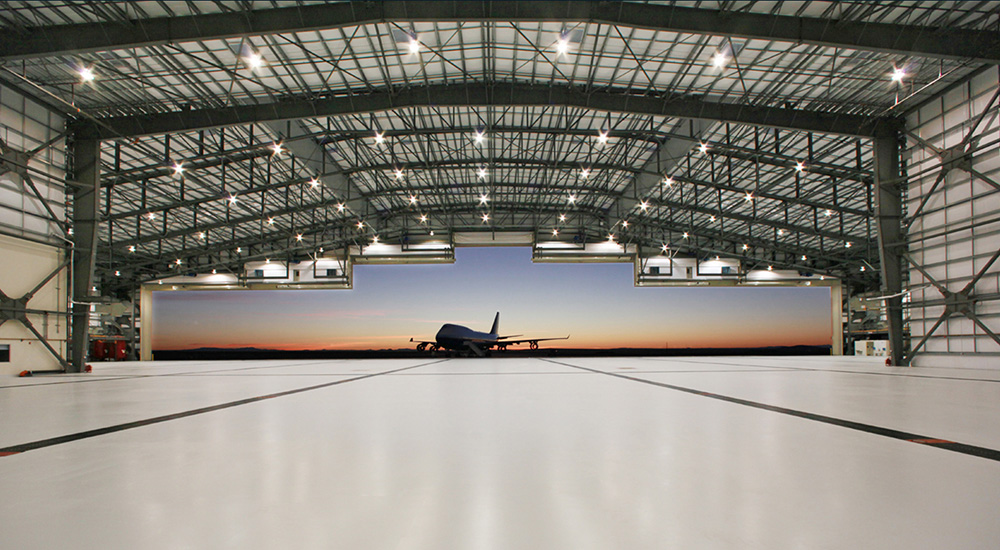The 3 Largest Hangars in the United States: Where Giants Sleep
Published on May 19, 2025 • 5 min read

Ever walked into your garage thinking it felt spacious? America's largest hangars would make your two-car garage look like a matchbox. These structures are so massive they create their own weather systems inside – some actually experience indoor rainfall.
These aren't just impressive monuments to engineering. They're masterclasses in operational efficiency that every FBO manager should study. While you may never manage 600,000 square feet of hangar space, the principles that make these giants profitable are the same ones that can transform your 15,000 sq ft operation.
Let's tour the three largest hangars in the United States, where aircraft rest and maintenance crews navigate vast spaces – and discover what their 90+ years of operational excellence can teach modern FBO operations.
1. Hangar 375 "Big Texas" – San Antonio, Texas
Hangar 375 in Texas lives up to the state's reputation for size. Officially recognized by Guinness World Records as the largest free-standing hangar on Earth, this 600,000-square-foot monster at Kelly Air Force Base (now Port San Antonio) is basically a small city with a roof.
Built in 1956, "Big Texas" can comfortably accommodate 15 wide-body aircraft simultaneously. The hangar spans 2,000 feet by 300 feet, with doors that weigh 608 tons each – heavier than a fully loaded Airbus A380.

The concrete apron surrounding Big Texas covers 44 acres – roughly equivalent to 33 football fields of concrete exclusively designed for B-52 bombers.
The Modern FBO Lesson: Big Texas perfected the art of multi-aircraft positioning – something today's FBOs struggle with constantly. Their predetermined parking positions and systematic aircraft placement principles are exactly what modern hangar management software and 3D stacking optimization replicates, just on a smaller scale.
2. Goodyear Airdock – Akron, Ohio
Long before modern drones, America built massive airships that required equally massive facilities. Enter the Goodyear Airdock in Akron, Ohio – a structure so large it creates its own indoor weather patterns.
Completed in 1929 for $2.2 million (about $37 million in today's money – still a bargain for something this huge), the Airdock stretches 1,175 feet long, 325 feet wide, and 211 feet high. That's approximately 14 stories tall.
When humidity is high and temperature changes suddenly, it literally rains inside the building. Workers have reported needing umbrellas indoors – making it possibly the only workplace where you need to check the indoor weather forecast.

The building's doors deserve their own mention – each weighs 600 tons and has its own power plant. These aren't doors; they're moveable buildings. The entire structure sits on rollers to compensate for expansion and contraction – essentially a 55-million-cubic-foot engineering marvel.
The Modern FBO Lesson: The Airdock's moveable partition system solved the same problem FBOs face today – how to accommodate different aircraft sizes efficiently. Those 1929 engineers understood that flexible space allocation drives profitability, a principle that modern FBOs are rediscovering with dynamic pricing and flexible lease terms.
3. Hangar One – Mountain View, California
In the heart of Silicon Valley sits Hangar One at Moffett Field – a structure so iconic it's become a landmark for tech workers stuck in traffic on Highway 101. Built in 1933 to house the USS Macon airship, this 8-acre behemoth could cover six football fields under its canopy.
At 1,133 feet long, 308 feet wide, and 198 feet tall, Hangar One is like the cool, slightly smaller sibling to the Goodyear Airdock. But what it lacks in size, it makes up for in drama. The hangar has been through more costume changes than a pop star – its toxic exterior panels were removed in 2011, leaving it as a massive skeleton that looks like something from a post-apocalyptic movie.
Google (now Alphabet) secured a 60-year, $1.16 billion lease to restore it. A tech company is investing over a billion dollars to rehabilitate a 90-year-old hangar – a testament to the enduring value of well-designed aviation infrastructure.

The Modern FBO Lesson: Hangar One's story perfectly illustrates the long-term value of hangar assets. Built in 1933, it's still commanding premium prices 90+ years later. For FBO managers, this demonstrates why investing in proper hangar infrastructure – adequate height, flexible design, quality construction – pays dividends for decades.
Operational Lessons from the Giants: What FBO Managers Can Learn
While these massive hangars operate on a scale most FBOs will never see, the operational principles behind their success translate directly to smaller operations. Here's what 90+ years of large-scale hangar management teaches us:
Space Optimization Principles That Scale
Modular Design Philosophy: Notice how these mega-hangars can accommodate different aircraft types simultaneously. The Goodyear Airdock's original airship design used moveable partitions – the same principle applies to modern FBO operations where flexible space allocation and best practices let you maximize revenue per square foot.
Door Engineering Matters: Those 600-ton doors weren't just built for show. Large, efficient door systems minimize aircraft movement time and reduce operational bottlenecks. For smaller FBOs, investing in proper door systems (hydraulic vs. manual) can cut aircraft turnaround time by 15-20 minutes per movement.
Traffic Flow Design: Big Texas and similar facilities use predetermined taxi patterns to prevent aircraft conflicts. Even in a 40,000 sq ft hangar, establishing clear taxi lanes and positioning protocols prevents the costly delays that happen when aircraft block each other.
Real-World Utilization Benchmarks (2024 Data)
The aviation industry has specific metrics that separate successful hangar operations from struggling ones:
Industry Utilization Standards:
- Optimal hangar utilization: 85-90% occupancy during peak seasons
- Revenue per square foot: Top-performing FBOs achieve $8-12 annually
- Construction costs: New hangar construction averages $60-120 per square foot (2024)
- Operational efficiency: Best-in-class FBOs turn aircraft in under 45 minutes
Technology Integration: Modern hangar management systems like HangarIT™ and Sky View use real-time tracking to achieve utilization rates that would make these historic hangars jealous. LiDAR sensors and automated positioning systems can increase your effective capacity by 15-25% without adding square footage.
Design Principles That Drive Revenue
Height Optimization: These giant hangars teach us that vertical space is just as valuable as floor space. Modern FBOs are building 28-30 foot door heights to accommodate larger business jets – the same aircraft that generate 3x the revenue per square foot of smaller aircraft.
Operational Flow: The Airdock's moveable partitions and Big Texas's multi-aircraft capacity show that flexibility drives profitability. FBOs using moveable barriers and flexible lease terms report 40% higher revenue per square foot than fixed-layout facilities.
Scaling Down: From 600,000 to 15,000 Square Feet
Here's how these mega-hangar principles translate to typical FBO operations:
The "Big Texas" Multi-Aircraft Approach:
- Mega-hangar: Houses 15 wide-body aircraft with predetermined positioning
- Your FBO: Use painted positioning guides for 6-8 aircraft in a 15,000 sq ft space
- Implementation: Create a simple floor marking system showing optimal aircraft placement for maximum density
- Result: Increase capacity from 4-5 aircraft to 6-8 without expanding
The "Airdock" Flexible Space Method:
- Mega-hangar: Moveable partitions adapt to different airship sizes
- Your FBO: Install moveable barriers or use flexible lease agreements
- Implementation: Designate 30% of space as "flex zones" that can accommodate transient aircraft or expand permanent leases
- Result: Boost revenue per square foot by 25-40% through dynamic space allocation
The "Hangar One" Height Utilization Strategy:
- Mega-hangar: 198-foot ceiling accommodates any aircraft
- Your FBO: Build 28-30 foot doors to handle larger business jets
- Implementation: When renovating or expanding, prioritize door height over width
- Result: Access to Global 7500s and similar aircraft that pay 3x more per square foot
Traffic Flow Optimization:
- Mega-hangar: Predetermined taxi patterns prevent conflicts
- Your FBO: Paint taxi lanes and establish one-way traffic flow
- Implementation: Use contrasting paint colors to create clear movement paths
- Result: Reduce aircraft movement time by 15-20 minutes, preventing costly delays
Modern Hangar Design Principles for FBO Success
Building on lessons from these aviation giants, here are the key design principles every FBO manager should prioritize:
1. Accessibility and Safety Integration
- Emergency systems: Install multiple emergency exits positioned for quick aircraft evacuation
- Fire suppression: Modern foam systems with zone-based activation (cost: $8-15 per sq ft)
- Lighting design: LED high-bay systems with motion sensors reduce operating costs by 40%
- Ventilation: Proper air circulation prevents condensation and protects aircraft finishes
2. Ergonomic Considerations for Operations
- Work platform systems: Adjustable platforms reduce maintenance crew fatigue and injury risk
- Tool storage: Centralized tool cribs with electronic tracking reduce search time by 60%
- Office integration: Elevated offices with hangar floor visibility improve operational oversight
- Climate control: Zones-based HVAC systems maintain comfort while controlling costs
3. Revenue-Optimized Layout Planning
- Flexible lease boundaries: Design for 20% annual lease changes without structural modifications
- Utility distribution: Overhead power and compressed air systems maximize floor utilization
- Equipment storage: Dedicated GSE areas prevent equipment from consuming profitable aircraft space
- Customer amenities: Pilot lounges and conference rooms positioned for easy access without compromising operations
4. Technology Infrastructure Requirements
- Sensor pre-wiring: Install conduit for future LiDAR and monitoring systems
- High-speed internet: Fiber connections support modern avionics updates and customer needs
- Security systems: Integrated access control with aircraft-specific permissions
- Management software: Cloud-based systems for real-time utilization tracking and billing
5. Operational Efficiency Standards
- Door specifications: Hydraulic systems with 3-4 minute full opening cycles
- Floor systems: Sealed concrete with chemical resistance and non-slip coatings
- Drainage: Proper floor slopes and drain placement prevent water accumulation
- Maintenance access: Built-in infrastructure for routine building maintenance without disrupting operations
Industry Success Patterns: What's Working in 2024
While specific case studies are closely guarded by competitive FBOs, industry trends reveal clear patterns of success:
Technology-Driven Growth: FBOs implementing digital hangar management systems report 15-25% improvements in space utilization. The FBO market reached $27.5 billion in 2024 and is projected to grow at 5.1% CAGR through 2033, with hangar services as a key revenue driver.
Premium Service Integration: FBOs offering luxury hangar amenities (private lounges, concierge services, gourmet catering) capture higher-value customers willing to pay premiums for exclusive experiences. This approach directly mirrors how these historic hangars served prestigious military and commercial operations.
Operational Efficiency Focus: With fuel sales stagnating in 2024 (60% of FBOs reported no growth), successful operations are pivoting to hangar revenue optimization. Top-performing FBOs achieve $8-12 per square foot annually through strategic space management.
Construction Cost Reality: With hangar construction costs up 30% since 2021, FBOs are maximizing existing space rather than expanding. This makes the operational lessons from these mega-hangars even more valuable – they perfected efficiency techniques that modern FBOs desperately need. Calculate your potential ROI from optimizing your existing space.
Digital Transformation Impact: Online booking platforms, mobile apps, and CRM systems are driving customer satisfaction and loyalty. The most successful FBOs are combining these digital tools with the timeless space optimization principles demonstrated by Big Texas, the Airdock, and Hangar One.
Size and Smart Operations
These three titans of American engineering aren't just big buildings – they're monuments to operational excellence at scale. From housing military bombers to cradling airships to potentially storing whatever secret projects Google has planned, these hangars have seen it all because they were designed with operational efficiency as the primary goal.
The next time you're struggling to fit one more Citation into your hangar, remember that somewhere in America, someone operates a hangar door weighing more than 100 elephants every morning without issue. These facilities demonstrate that even the most complex operations can run smoothly with proper planning.
Whether you're managing a modest 15,000 sq ft FBO hangar or dreaming of operations on this scale, one thing's certain: efficient space utilization is key. Even in a 600,000-square-foot hangar, every inch counts when you're trying to fit one more aircraft in before that storm rolls through – and the same principles that make these giants profitable can transform your operation.
Optimize Your Hangar Operations
While your hangar might not be breaking any world records, you can still maximize every square foot with intelligent space planning. Learn how AirPlx helps FBOs increase hangar revenue by up to 40% through smart optimization.


